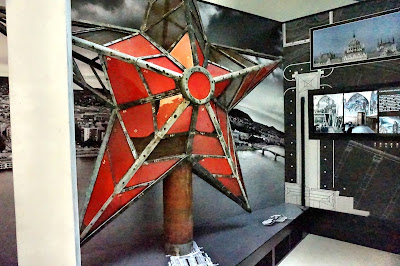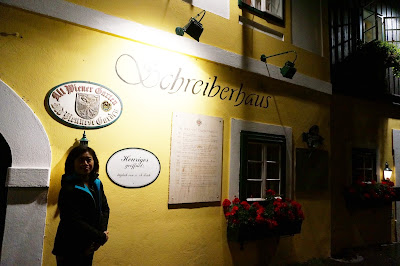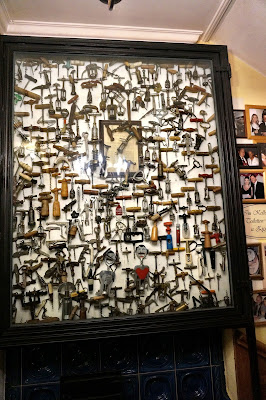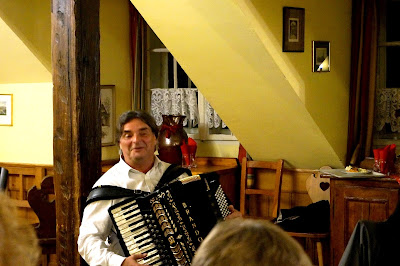It was still raining when we arrived at the Parliament building. There was military processing in progress to commemorate the Memorial Day for the Martyrs. The martyrs were some revolutionists who died in the Hungarian Revolution in the mid 19th century.
Here is the picture of the square in front of the Parliament building.
(Click on each picture to get the full-size view)
A military marching band and mounted cavaliers were in a formation observing the memorial service. It was very early in the morning and the square was lightly packed with tourists waiting in line to get inside the Parliament building.

The Parliament building is a Neo-Gothic architecture with elements of Renaissance and Baroque mixed in. It’s modeled after the UK Parliament and is considered the third largest Parliament building in the world.
A view of the Kossuth Square in front of the Parliament building
On the narrow end of the Kossuth Square is a monument for the Hungarian Revolution.
Directly facing the Parliament building on the opposite side of the square is a Neo-Renaissance palace for the Ethnographical Museum.
On the far left of this picture is another gigantic building facing the Parliament building on the opposite side of the square. It is the Neo-Classical building for the Ministry of Agriculture.
We entered the Parliament building from its side entrance.
A brilliant gilded stair leads to the upper floor lined with government offices.
Glittering and blinding arch ceiling reminds me of an old song “All that glitters is not gold”.
Probably the most impressive and sumptuous corridors in any government building in the world.
The extravagant main entrance stairs and hall.
The Hungarian Crown Jewels were on display in a rotunda under the big dome of the building. We were not allowed to take pictures. Needless to say, the Holy Crown is very impressive.
When Hungarian’s legislature was once bicameral, it built two chambers in the Parliament building for its Upper House and Lower House. Since its legislature changed to unicameral, it has only needed to use one chamber. The old Upper House Hall now mainly functions as a venue for ceremony, conference, and tourism.
The intricate ceiling of the old Upper House Hall.
Outside the hall of the legislature is the lobby area. On the windowsill are rows of cigar ashtrays made of brass.
During the Communist era, this large red star was mounted above the dome of the Parliament building. After the collapse of the Communist rule, the star was removed and put on display.
Our next stop for the morning was St. Stephen’s Basilica.
The basilica building itself is of neo-Classical style, with a rebuilt Neo-Renaissance dome. On the top left of this picture is one of the two bell towers. During WWII, Germans looted the heavy bell from one of these two towers. After the war, German sent back a replacement.
On the back of the basilica, statues of 12 Apostles adorn the parapet.
On the main portal to the church, busts of 12 Apostles are carved on the main door.
The basilica is very big. It can accommodate 8000 churchgoers. We stood in the main nave with the main altar in the back.
The church organ.
Our last stop for the morning was the Great Market Hall. It is the largest indoor market in Budapest, with a huge variety of stalls on three floors. There are many stalls that sell spices such as paprika. Many food stalls are located on the second floor. We had our lunch in this lively market.
We finally departed Budapest in the early afternoon. Vienna was 150 miles away and it took about two and a half hours to get there. We drove through Austrian villages and noticed how organized and tidy each farmhouse looked. There was nothing straying in the yard around the house. Everything seemed neat and orderly. No leafy trash, no pile of loose hay, not a farm tool or machinery left alone in plain sight. Many farmhouses had flowers planted around them. It was quite pleasant to look at the uncluttered scenery.
We stayed at Hilton Vienna at City Park. The hotel is conveniently located next to a park and a small shopping mall. We checked into our room and immediately felt that we were home. It’s a Hilton so everything felt American. The bath towels were big and thick, the pillows huge, the bed sheet soft, and the bathtub drains flawlessly. We also found out the next day that the breakfast buffet in the hotel had the most selections. We liked all the hotels we stayed so far on this trip, but this Hilton was the best. The only drawback was that we needed to go to the lobby to use free WIFI.
We signed up for an optional Austrian country dinner. The restaurant was near Vienna Woods, a highland overlooking Vienna. Before the dinner began, our bus took us up the hill to get a good view of the city.
The restaurant, Das Schreiberhaus, is on a busy street lined with similar country restaurants.
The restaurant owner has a good collection of corkscrews.
The largest corkscrew I have ever seen.
During dinner, we were entertained by an accordion player who sang both Austrian and American folk songs.
I have no memory of the food we had on this particular night. But by looking at this picture with all the empty plates, I am sure the food must have been very good.
Tomorrow we would start our Vienna tour.
Hungarian Parliament - a testament of extreme extravagance and magnificence
St. Stephen’s Basilica - a combination of Neo-Gothic and Neo-Renaissance
Great Market Hall - a big tent for nobles and peasants
And finally, Vienna - the city of Habsburg and Mozart
-Joe
P.S. I wrote this travelogue on 11/08/2016 and Donald Trump was just elected as the US President on this night.



































No comments:
Post a Comment